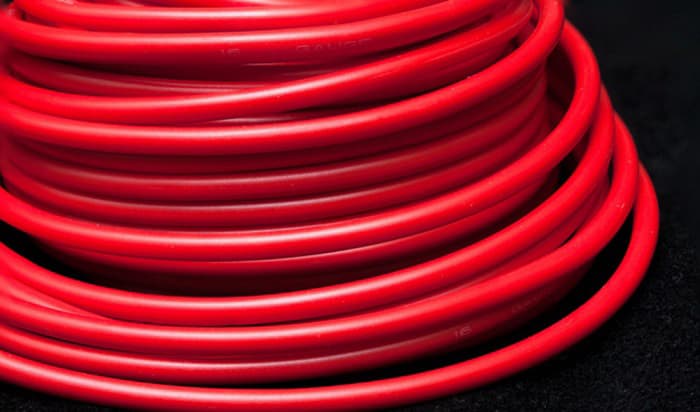“How many amps can a 16 gauge wire handle?” This question gets asked a lot by vehicle owners and audio hardware enthusiasts rather than people concerned with wiring their home’s circuits.
At best, 16 AWG is suitable for loads up to 10 amps or 13 amps in minor applications (such as extension cords or speaker wires).
Based on Table 310.16 of the NEC, 16 AWG copper wires are suitable for up to 18 amps in standard circuits with insulation and terminations rated for 90°C. Continuous loads used with this size should not exceed 8 amps.
Table of Contents
The Correct Amperage Capacity of 16 Gauge Wire
There are many conflicting answers with regard to the correct 16 gauge wire amps limit. Some electrical engineers will go by the book and quote the NFPA70, which points to 10 amps as the limit instead.
If you’re trying to wire circuits using 16 AWG wires, it’s likely best to follow this recommendation. However, we can’t deny that there are 16 AWG extension cords, power cords, and wire speakers out there that are rated for 13 amps.
The thing is both 13 amps and 10 amps are correct, at least, according to your standard UL-backed electrical wire size chart.
The 10A and 8A local code guideline from sections 240.4(D)(1) and (2) of the NEC is more concerned with circuit breaker protection. If that is what you’re going to be using the 16 gauge wire for, you need to make sure that either the breaker or fuse is suitable for that wire.
These capacities apply to wiring runs that are less than or exactly 50 feet. Anything over that decreases the ampacity to 10 amps and 7 amps, respectively.
These low-duty specs are why 16 gauge wires are only known for minor applications on speakers, batteries, and extension cords.
If you look online yourself, you’ll see that there’s no shortage of 16 AWG cords, cables, and wires being sold out there that have an exact 13A maximum rating.
Overall, though, it’s admittedly hard to pinpoint an exact wire gauge amps capacity, especially if we factor in the assembly and possible fluctuations in temperature.
We can only surmise a range once these enter the picture, with the values said above serving as the uppermost limit, hence, the “maximum” tag on product labels.
The best step is to rely on the amperage values shared by cable manufacturers, regardless of your intention for using 16 gauge wires. Even better if you use both local code and manufacturer’s specifications for your particular situation.
Based on Voltage
Are you wondering whether voltage has any bearing on the max amperage of a particular 16 gauge cord?
To be completely clear, no, since current determines the wire’s size while voltage is more related to its insulation. With that in mind, it’s high time for users to disregard how many volts they’re dealing with as far as wire gauges/sizes are concerned.
The amperage may vary, though, but it’s more likely influenced by the wire’s assembly and other conditions that affect temperature (e.g. insulation used), as mentioned above.
- Incidentally, if you’re wondering how many watts 16 AWG wires have, at 12 volts, 16 gauge wire watts may vary between 50W and 120W.
- Most 120V and 240V 16 AWG wires and extension cords both have maximum amp ratings of 13A, but, of course, they can still work for current draws lower than that limit.
But, again, it’s better just to call the manufacturer and get their wire gauge measurements.
Types of 16 Gauge Wire
16 gauge wires stand out in that they’re only available as copper wire. The columns in Table 310.16 prove this.
So, when I shared the 16 gauge wire amperage suggestions above, I was referring to that kind of wire.
If we’re going by the 16 AWG ampacity from the said table, which says it’s 18 amps, then its closest counterpart is a 12 AWG aluminum wire, which tops out at 20 amps under 75 degrees and 25 amps when temperatures reach 90°C.
For more about how many amp 12 AWG wires have, click here!
FAQs
How long will sixteen gauge wire run before a voltage drop?
At 100 feet, the voltage drop for a typical 10A power source using 16 gauge wires will be around 8V already. At 300 feet, it balloons to twice that amount at 24V, which is already way too impractical.
It’s best to upgrade to a larger wire size if you know that you’ll be stretching yourself too thin with a 16 AWG wire.
Can you tie 16 gauge wire into 18 or 14?
There’s no problem with connecting a 18 gauge wire to a 16 gauge one or a 14 gauge wire to 16 gauge as well. Firstly, make sure the resultant setup is well insulated.
Furthermore, if you’re doing the splicing for a circuit (if it’s at all possible for these wire gauges), you need to ensure that the breaker or fuse protecting them is appropriately sized for the smaller gauge wire.
What is a 16 gauge wire rated for?
It’s rated for use in power cords and extension cords or circuits with comparatively minor loads. Don’t expect it to be used for major loads found in a regular house.
How much current can a 16 AWG wire carry?
13A for cables and power cords. For circuits at 90°C, it can have an amperage capacity of up to 18A, but local code guidelines may limit it to 10A or 8A for a continuous load.
Conclusion
Have the points I’ve given cleared up your confusion over amperage figures in your standard wire gauge chart? Refer to the ranges above, while minding the different factors that may affect amperage carrying capacity.
But don’t hesitate to contact the manufacturer to confirm whether your prospective 16 gauge wire or cord is, indeed, applicable to your intended purpose.
Now that you’re well aware of the answer to “How many amps can a 16 gauge wire handle?” I hope that you won’t mind sharing this with anyone who happens to have the same question.

I am Edwin Jones, in charge of designing content for Galvinpower. I aspire to use my experiences in marketing to create reliable and necessary information to help our readers. It has been fun to work with Andrew and apply his incredible knowledge to our content.



